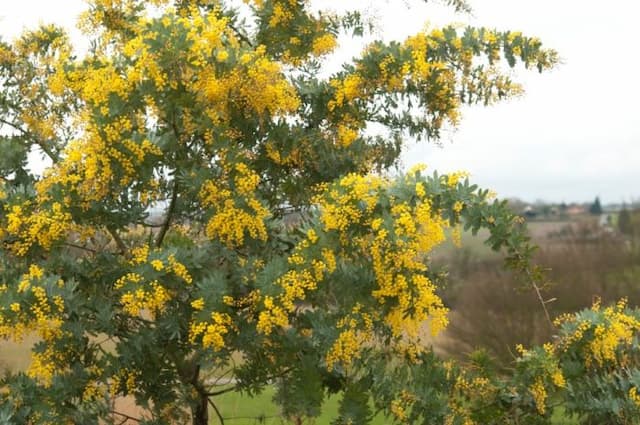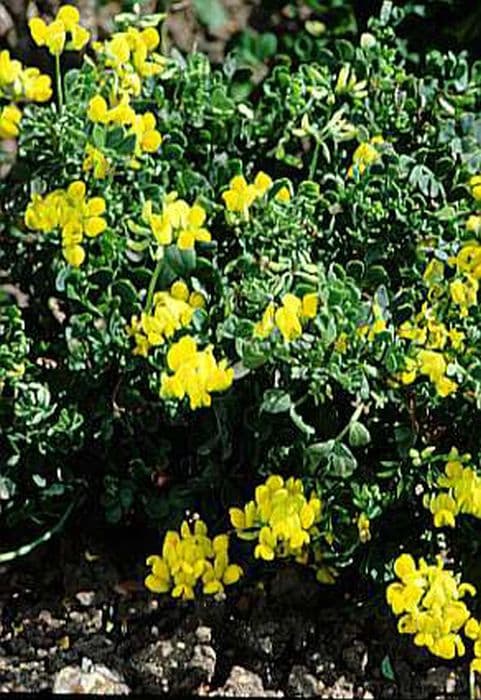Kangaroo Thorn Acacia paradoxa

ABOUT
Acacia paradoxa, commonly known as the Kangaroo Thorn, is a dense and spiny shrub with a complex and formidable appearance. The plant is widely recognized for its intricate array of sharp, needle-like thorns that densely cover its branches, providing a protective barrier against grazing animals. These thorns can give the plant a somewhat tangled and impenetrable look. The foliage of the Kangaroo Thorn consists of small, bright green leaves which are often oval to elliptical in shape. During the flowering season, it produces an abundance of small, round, fluffy yellow flowers that are arranged in globular clusters and emit a sweet fragrance, attracting a variety of pollinators. The flowers stand out against the green leaves, adding a splash of color to its visage, and they eventually give way to seed pods. These pods are typically straight or slightly curved, firm, and often tightly packed with seeds. The seeds within are generally small and may exhibit variations in color from plant to plant. Overall, the Kangaroo Thorn has a rugged, bushy, and somewhat chaotic appearance. Its combination of spiny defense mechanisms, lush leaves, vibrant flowers, and seed pods make it a distinctive plant, particularly well-suited for survival in challenging environments.
About this plant
 Names
NamesFamily
Fabaceae.
Synonyms
Kangaroo Thorn, Hedge Wattle, Paradox Acacia.
Common names
Mimosa paradoxa, Acacia armata var. paradoxa, Racosperma paradoxum.
 Toxicity
ToxicityTo humans
Kangaroo Thorn is not widely known for any significant toxicity to humans. However, like many plants, it may cause mild discomfort if ingested, such as gastrointestinal upset. It is more commonly an issue of physical injury due to its sharp thorns rather than poisoning. The plant does not typically cause serious poisoning in humans, so specific symptoms related to toxic compounds are not well-documented. Care should be taken to avoid the physical hazards of the plant rather than concern for toxicity.
To pets
Kangaroo Thorn is not specifically known for being toxic to pets, but as with humans, the physical injury from its thorns can be a concern. Ingesting parts of the plant may potentially cause mild stomach upset in pets, as is common with many non-food plants. The primary concern would be to prevent physical injury to pets due to the plant's thorny nature. Signs of poisoning in pets are not commonly reported, so there are no well-documented symptoms of poisoning from this plant in the veterinary literature. Owners should always monitor their pets if they have ingested any part of an unknown plant and consult a veterinarian as a precaution.
 Characteristics
CharacteristicsLife cycle
Perennials
Foliage type
Evergreen
Color of leaves
Green
Flower color
Yellow
Height
6-10 feet (1.8-3 meters)
Spread
6-10 feet (1.8-3 meters)
Plant type
Shrub
Hardiness zones
9
Native area
Australia
Benefits
 General Benefits
General Benefits- Erosion Control - Acacia paradoxa's extensive root system helps stabilize soil and prevent erosion.
- Habitat Provision - It provides shelter and nesting sites for various wildlife species.
- Food Source - The seeds are a food source for birds and other animals.
- Nitrogen Fixation - Like many legumes, it enriches the soil by fixing nitrogen, improving fertility for other plants.
- Drought Tolerance - Being a native to arid environments, it is well-suited to landscapes that require drought-tolerant plants.
- Windbreak - Its dense growth can be used as a windbreak to protect crops and soil.
- Ornamental Use - With its intricate foliage and bright yellow flowers, it is sometimes used in ornamental plantings.
- Boundary Definition - Its thorny nature makes it useful for defining property boundaries and deterring trespassers.
- Support for Beneficial Insects - It offers resources for pollinators and other beneficial insects.
 Medical Properties
Medical Properties- Anti-inflammatory: Extracts of Acacia paradoxa may possess anti-inflammatory properties, which can help reduce inflammation in the body.
- Antioxidant: The plant contains compounds that could exhibit antioxidant effects, helping to protect cells from damage caused by free radicals.
 Air-purifying Qualities
Air-purifying QualitiesThis plant is not specifically known for air purifying qualities.
 Other Uses
Other Uses- Acacia paradoxa, also known as kangaroo thorn, can be used to create dense hedges due to its thorny branches, providing a physical barrier against intruders and large animals.
- The hard wood of kangaroo thorn can be used for making small wooden tools and handles, where strength and durability are desired.
- Traditional indigenous Australians may have used the twigs and foliage of kangaroo thorn for making fish traps or woven items.
- Kangaroo thorn is sometimes used in environmental management for soil stabilization and revegetation projects, thanks to its robust growth in poor soils.
- Some people may use the bark and seed pods of kangaroo thorn in tanning, as they contain tannins that can be used to process leather.
- As an ornamental plant, kangaroo thorn offers an aesthetic value to gardens with its striking yellow flowers during the blooming season.
- Kangaroo thorn seeds are a source of food for wildlife, particularly birds, which help in the dispersal of the seeds to propagate new plants.
- The dense foliage of kangaroo thorn provides a natural habitat for small birds and insects, thus contributing to biodiversity in the area.
- Bees are attracted to the flowers of the kangaroo thorn for pollination, and in return, the plant can be beneficial for local beekeepers as a source of nectar.
- Due to its thorny and dense nature, kangaroo thorn can also be used for erosion control by securing loose soil on slopes and banks.
Interesting Facts
 Feng Shui
Feng ShuiKangaroo Thorn is not used in Feng Shui practice.
 Zodiac Sign Compitability
Zodiac Sign CompitabilityKangaroo Thorn is not used in astrology practice.
 Plant Symbolism
Plant Symbolism- Resilience: Acacia paradoxa, commonly known as Kangaroo Thorn, is a tough, hardy plant able to thrive in harsh environments, symbolizing the ability to withstand difficult conditions.
- Persistence: The plant's vigorous growth and tenacious hold on the land it grows in reflect qualities of determination and persistence.
- Protection: With its thorny exterior, Kangaroo Thorn represents protection and defense, often used as a natural barrier against intruders.
- Purity: In certain cultures, acacias are associated with purity due to their common use in religious and sacred contexts.
- Friendship: Acacia flowers are sometimes given as a symbol of friendship, with the plant's enduring nature reflecting lasting bonds.
- Eternal and Unconditional Love: Acacias can signify everlasting love, with their perennial growth habit representing love that does not fade with time.
 Water
WaterKangaroo Thorn should be watered deeply but infrequently to mimic its native arid environment. During the growing season, watering every two weeks can suffice, providing about 1 to 2 gallons per watering session if the plant is established. Younger or recently planted specimens may require water once a week until they are well-established. During the winter months or dormant periods, reduce watering to once a month or less, depending on rainfall. It's important to ensure that the soil drains well as the plant does not tolerate waterlogged conditions.
 Light
LightKangaroo Thorn thrives in full sunlight, meaning it should receive at least six hours of direct sunlight daily. The best spot for this plant would be in an area where it can enjoy unfiltered sunlight throughout the day. Partial shade can be tolerated, but for optimal growth and flowering, a location with full sun exposure is ideal.
 Temperature
TemperatureKangaroo Thorn is adapted to a wide range of temperature conditions and can survive in temperatures as low as 20 degrees Fahrenheit and as high as over 100 degrees Fahrenheit. The ideal temperature for the plant is between 60 and 85 degrees Fahrenheit. It is a hardy plant that can tolerate occasional frosts but thrives in warmer temperatures.
 Pruning
PruningPruning Kangaroo Thorn is done primarily to maintain shape, remove dead wood, and encourage bushier growth. It is best to prune in late winter or early spring before new growth begins. Prune no more than one-third of the plant at a time to keep it healthy. Regular pruning every year or two is generally sufficient.
 Cleaning
CleaningAs needed
 Soil
SoilThe best soil mix for Kangaroo Thorn (Acacia paradoxa) should be well-draining with low fertility; a mix of sand and loamy soil is ideal. The preferred soil pH range is between 6.0 to 7.5.
 Repotting
RepottingKangaroo Thorn (Acacia paradoxa) typically doesn't require frequent repotting; it can be repotted every three to five years or when it has clearly outgrown its container.
 Humidity & Misting
Humidity & MistingKangaroo Thorn (Acacia paradoxa) is tolerant of a wide range of humidity levels and does well in dry environments typical of its natural habitat.
 Suitable locations
Suitable locationsIndoor
Place Kangaroo Thorn in bright light indoors.
Outdoor
Plant Kangaroo Thorn in full sun, well-draining soil.
Hardiness zone
8-11 USDA
 Life cycle
Life cycleAcacia paradoxa, commonly known as Kangaroo Thorn or Hedge Wattle, begins its life as a seed, which typically requires scarification or heat treatment to break dormancy, often through natural events such as fire. Upon germination, the seedling develops a deep taproot and starts growing compound leaves, with thorns forming early to deter herbivores. The juvenile phase quickly transitions to a vegetative adult stage, where the plant establishes a bushy growth form and reaches reproductive maturity, displaying clusters of fragrant yellow flowers during late winter to early spring. Following pollination, often by bees, it produces pods containing viable seeds, which are later dispersed by wind, water, or animals. Acacia paradoxa is able to resprout from the base if the above-ground parts are damaged by events such as grazing or fire. Throughout its life, which can span several decades, the plant forms symbiotic relationships with soil bacteria for nitrogen fixation, crucial for its survival in nutrient-poor soils.
 Propogation
PropogationPropogation time
Spring to summer
Propogation: The most popular method of propagation for Acacia paradoxa, commonly known as Kangaroo Thorn, is through seed. Seeds of Kangaroo Thorn typically require pre-treatment to break their physical dormancy caused by the hard seed coat. This is often achieved by scarification, where the seed coat is physically scratched or nicked to allow water absorption. An alternative method is to pour boiling water over the seeds and let them soak until the water cools to room temperature, which often results in the seeds swelling. Once treated, the seeds are sown in well-drained soil mix and kept moist until germination occurs. Sowing is best done in spring or autumn to take advantage of the mild temperatures that facilitate seedling growth. Seedlings can then be potted on and grown until they are large enough to be transplanted into their final position.









